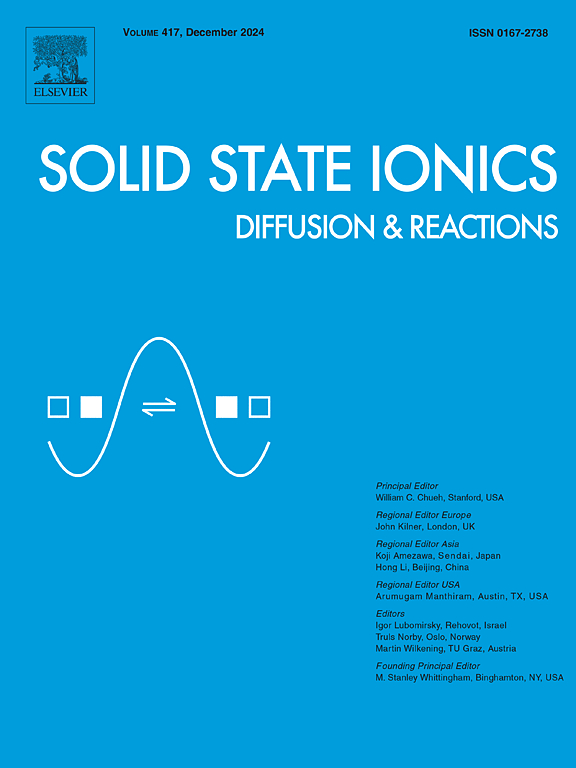The road to high-entropy: Combinatorial sequential doping study of Ba2In2O5
IF 3.3
4区 材料科学
Q3 CHEMISTRY, PHYSICAL
引用次数: 0
Abstract
Ba2In2O5 is a rare-earth free material extensively explored for its remarkable oxygen-ion conductivity properties, highly sought after in the field of solid-state ionic and related devices. These properties can be activated at lower temperatures, and augmented with mixed ionic-electronic conductivity, by stabilization of its cubic perovskite phase through a variety of doping on the indium site. Following this reported flexibility, this study attempts a systematic doping of Ba2In2O5 with a variety of metals (Co, Cr, Fe, Mn, Ni, Sn, Ti, V, Zr), with incremental steps approached in a combinatorial fashion; starting from one dopant, we provide various combinations of 2, 3, and 4 dopant options, with the latter representing the first high-entropy perovskite doping attempt on this system. Out of the 48 attempted composition, 8 yielded novel stable Pm-3m perovskites, of which one high-entropy perovskite and two medium-entropy perovskites; additionally, three more composition in medium entropy range and one more composition in high entropy range approached stability with minimal splitting. Through thermogravimetric analysis, all cubic compounds showcased reversible evolution of oxygen upon heating. The phase stabilization of a single phase multi-doped system appears to be the result of a complex relationship between element sizes, charges and orbital configurations. While increases in entropy of the indium sublattice were always accompanied by reduced oxygen mobility onset temperatures, we critically assessed the pairwise interaction between different metals and their impact on mobile oxygen quantities in different temperature ranges (500 to 900 °C). Is high-entropy always achievable in a system with appropriate flexibility? If so, it is actually beneficial in its impact on the materials properties? The results of this study highlight interesting avenues for compositionally complex oxides.
高熵之路:Ba2In2O5的组合序贯掺杂研究
Ba2In2O5是一种无稀土材料,因其优异的氧离子导电性而被广泛开发,在固态离子及相关器件领域备受追捧。这些性能可以在较低的温度下被激活,并通过在铟位点上掺杂各种物质来稳定其立方钙钛矿相,从而增强混合离子-电子电导率。根据报道的这种灵活性,本研究尝试用各种金属(Co, Cr, Fe, Mn, Ni, Sn, Ti, V, Zr)系统掺杂Ba2In2O5,并以组合方式逐步接近;从一种掺杂剂开始,我们提供了2,3和4种掺杂剂的各种组合选择,后者代表了该体系上第一次高熵钙钛矿掺杂尝试。在48种尝试的组合物中,有8种获得了新的稳定的Pm-3m钙钛矿,其中一种是高熵钙钛矿,两种是中熵钙钛矿;另外,在中熵范围内又有3个组分和在高熵范围内又有1个组分以最小的分裂接近稳定。通过热重分析,所有立方化合物在加热时都表现出可逆的氧演化。单相多掺杂体系的相位稳定似乎是元素尺寸、电荷和轨道构型之间复杂关系的结果。虽然铟亚晶格熵的增加总是伴随着氧迁移起始温度的降低,但我们严格评估了不同金属之间的两两相互作用及其在不同温度范围(500至900°C)下对氧迁移量的影响。在一个具有适当灵活性的系统中,高熵是否总是可以实现?如果是这样,它对材料性能的影响实际上是有益的吗?这项研究的结果突出了组成复杂氧化物的有趣途径。
本文章由计算机程序翻译,如有差异,请以英文原文为准。
求助全文
约1分钟内获得全文
求助全文
来源期刊

Solid State Ionics
物理-物理:凝聚态物理
CiteScore
6.10
自引率
3.10%
发文量
152
审稿时长
58 days
期刊介绍:
This interdisciplinary journal is devoted to the physics, chemistry and materials science of diffusion, mass transport, and reactivity of solids. The major part of each issue is devoted to articles on:
(i) physics and chemistry of defects in solids;
(ii) reactions in and on solids, e.g. intercalation, corrosion, oxidation, sintering;
(iii) ion transport measurements, mechanisms and theory;
(iv) solid state electrochemistry;
(v) ionically-electronically mixed conducting solids.
Related technological applications are also included, provided their characteristics are interpreted in terms of the basic solid state properties.
Review papers and relevant symposium proceedings are welcome.
 求助内容:
求助内容: 应助结果提醒方式:
应助结果提醒方式:


